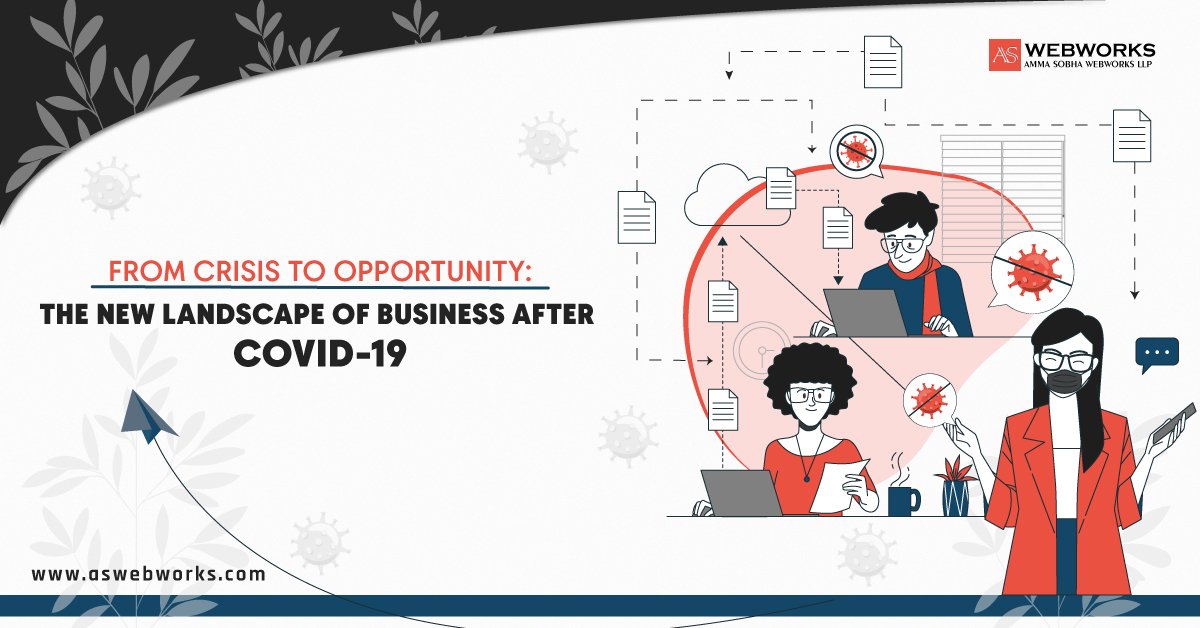The COVID-19 pandemic has permanently changed how international commerce is conducted. Organizations of all sizes are facing a new set of opportunities and challenges as the world starts to come out of the virus’s clutches. Following the worldwide epidemic, there have been changes in labour dynamics, consumer behaviour, technology, and economic landscapes. This blog explores these changes and provides tips and tactics for companies looking to prosper in the post-normal environment.
Business During COVID-19
The COVID-19 pandemic significantly altered the corporate environment by requiring organizations to quickly adjust to previously unheard-of issues. Lockdowns and social distancing measures caused supply chain disruptions, decreased consumer demand, and operating challenges for numerous firms around the world. The move to remote work became essential, hastening the use of virtual collaboration tools and digital technologies.

As more people shopped online, e-commerce flourished and traditional brick-and-mortar retailers found it difficult to stay in business. Businesses in the tourism, hospitality, and entertainment industries were especially hard impacted, leading to widespread layoffs and government actions. In contrast, companies in the healthcare, logistics, and technology sectors frequently experienced growth and higher demand.
The pandemic highlighted the value of adaptability, resilience, and creativity, prompting businesses to reconsider their approaches, make investments in digital transformation, and place a higher priority on the well-being of their employees.
Business After COVID-19
The corporate environment has entered a new age following COVID-19, one marked by resilience, adaptability, and digital transformation. Businesses are using technology more and more to improve consumer experiences, increase operational efficiency, and create stronger supply chains. The epidemic hastened the shift toward remote work, prompting some companies to establish hybrid work models that combine remote and in-office tasks while offering workers more flexibility. Because e-commerce is still growing, traditional merchants are being forced to adapt and include digital methods. Health and safety have taken centre stage, with companies putting strict policies in place to safeguard both clients and staff. The importance of tackling social and environmental issues has led to a greater emphasis on sustainability among businesses.

1) The Change in Customer Mindset
Consumer behaviour has changed significantly as a result of the pandemic, with a notable shift towards online purchases and digital interactions. During lockdowns, e-commerce saw unheard-of growth, and many customers have continued to shop online even after traditional businesses had reopened. In order to serve this permanently changed customer base, businesses must now place a high priority on their digital presence, making sure that online interactions are secure and seamless.
a. E-commerce and Digital Platforms
Businesses need to make investments in reliable e-commerce systems and make sure their websites are mobile-friendly, secure, and easy to use. In a congested online market, being visible and drawing clients requires social media integration and the use of digital marketing techniques like SEO, content marketing, and pay-per-click advertising.
b. Personalization and Customer Experience
Today’s consumers demand individualized service. Companies can use AI and data analytics to comprehend customer preferences and make customized recommendations. Building brand loyalty will mostly need improving the customer experience through quick and easy returns, attentive customer care, and effective delivery services.
2) Remote Work and Workplace Dynamics
The pandemic triggered a widespread movement in work practices toward remote work, proving that many tasks could be completed outside of conventional office settings. Companies are increasingly using hybrid work models, which combine in-office and remote labour, as they navigate the post-COVID landscape.

a. Adapting to Hybrid Work Models
Hybrid work environments need organizations to build infrastructure and policies. This entails making the proper resource allocations for remote workers, developing explicit communication standards, and investing in digital collaboration technologies. As firms move to these new models, adaptability and trust are essential.
b. Maintaining Company Culture
Intentional efforts are needed to maintain a strong company culture in a hybrid work environment. When done safely, regular virtual meetings, team-building exercises, and opportunities for face-to-face interaction can all contribute to the preservation of a feeling of community and belonging. In order to promote diversity and make sure that every employee feels appreciated and engaged, leadership must take the initiative.
3) Developments in Technology
Technology adoption has accelerated across industries as a result of the pandemic. Automation, machine learning, and artificial intelligence advancements are changing how businesses operate, increasing productivity, and opening up new business prospects.
a. Automation and Artificial Intelligence
Employees can concentrate on more strategic duties by using AI and automation to streamline repetitive operations. Companies ought to investigate the ways in which these technologies might boost decision-making, optimize supply chains, and improve customer service. Automation and human interaction must be balanced, though, especially in jobs that involve interacting with customers.
b. Cybersecurity
Cybersecurity is more important than ever due to the rise in digital connections. To safeguard sensitive data and uphold customer confidence, businesses need to make significant investments in cybersecurity solutions. Implementing cutting-edge security solutions, conducting regular security audits, and training staff on cyber hygiene are crucial actions.
4) Risk Management and Financial Strategies
The pandemic’s economic effects have brought attention to the significance of sound financial plans and efficient risk management. Companies need to be ready to handle financial risks and negotiate economic turbulence.
a. Cash Flow Management
Stability in business depends on efficient cash flow management. It is essential for businesses to consistently assess their cash flow forecasts, manage expenses, and preserve an adequate level of liquidity for handling economic ups and downs. Financial resilience can also be improved by diversifying sources of income.
b. Risk Assessment and Contingency Planning
Identifying possible risks and getting ready for unforeseen situations need regular risk assessments and contingency planning. To protect their operations, businesses should create thorough risk management strategies that include insurance coverage and crisis management procedures.
5) Environmental Responsibility and Corporate Social Responsibility
The epidemic has brought corporate social responsibility (CSR) and sustainability to light. Businesses are under growing pressure from stakeholders and customers to make constructive contributions to the environment and society.
a. Ecological Methods
It is not only morally right to integrate sustainable practices into company operations, but it also helps businesses succeed in the long run. Companies can make an effort to lessen their influence on the environment by implementing waste reduction strategies, energy-efficient procedures, and sustainable sourcing.
b. Community Engagement
A company’s reputation can be improved and customer loyalty can be increased by getting involved in the community and supporting social causes. Companies may help local communities, support social activities, and encourage inclusion and diversity within their own workforces.
6) Education and Skill Development
The quick speed of change requires ongoing education and skill improvement. Businesses that want to give their staff the skills they need for the future must engage in training and development initiatives.
a. Upgrading and Retraining
Initiatives aimed at improving and upskilling workers can aid in their adjustment to new technology and evolving job specifications. Giving staff members access to workshops, mentorship programs, and online courses can improve their professional development.
b. Culture of Constant Learning
Encouraging staff to stay curious and proactive in their professional growth is one way to foster a culture of continuous learning. Acknowledging and recognizing learning endeavours might encourage staff members to continue their education.
7) The Expansion of Markets and Globalization
There are fresh prospects for market expansion and globalization in the post-COVID era. For further expansion, companies can enlarge their global reach and investigate new markets.
a. Strategies and Market Research
Finding profitable expansion prospects requires conducting in-depth market research. Companies should create plans for their strategic entry, taking into account things like demand in the market, cultural differences, and local laws.
b. Collaborations
Establishing partnerships with nearby companies might make it easier to enter and grow new markets. Partnering with well-established organizations can yield important brand awareness, distribution channels, and market insights.
8) Innovation and Research & Development
In the dynamic corporate environment, innovation and research and development (R&D) are essential for maintaining competitiveness. To promote innovation and provide value, businesses need to spend money on R&D.

a. Promoting Creativity
Fostering a culture of experimentation and risk-taking is a necessary step in creating an environment that promotes innovation. Companies ought to encourage innovation and offer the tools necessary to create and test new concepts.
b. Investments in R&D
New services, technology, and products may result from R&D investments. Companies ought to commit funds to research projects that support their strategic objectives and customer demands.
Conclusion
The business situation following COVID-19 is marked by swift changes, unpredictability, and potential. Companies will be well-positioned to prosper in the new normal if they can adjust to changing consumer behaviour, embrace technology improvements, and cultivate inventive, flexible cultures. Organizations may foster resilience and long-term success by placing a high priority on sustainability, ongoing learning, and health and well-being. Strategic planning, imaginative leadership, and a dedication to having a positive social impact are necessary for navigating this new terrain. The lessons that were acquired during the pandemic will continue to influence business going forward, pointing organizations in the direction of a more inventive, inclusive, and resilient world.

